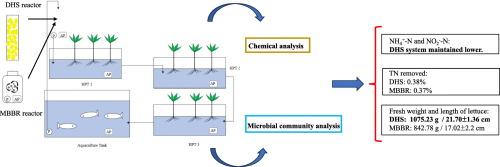下流式悬挂海绵反应器和移动床生物反应器在水生植物栽培系统中的性能比较
Q1 Environmental Science
引用次数: 0
摘要
鱼菜共生需要高质量的水净化,以实现鱼类和蔬菜的高产稳产。本研究调查了下流式悬挂海绵(DHS)反应器和移动床生物反应器(MBBR)在如意鱼-莴苣鱼菜共生系统中的性能。在高密度养鱼条件下,DHS-水产养殖池中的 NH4+-N 保持在 0.38 ± 0.26 mg-N-L-1 的低水平,而 MBBR-水产养殖池中的 NH4+-N 只有其有效容积的五分之一。此外,与 MBBR 系统(842.78 克和 17.02 ± 2.2 厘米)相比,DHS-水培系统生产的生菜量更大(1075.23 克),植株更长(21.70 ± 1.36 厘米)。这项研究表明,DHS 系统能有效降低铵态氮浓度,稳定水中的氮含量,提高水培系统的生态健康水平。因此,DHS 系统不仅能提高农业生产效率,还能促进农业可持续发展。本文章由计算机程序翻译,如有差异,请以英文原文为准。

Performance comparison of down-flow hanging sponge reactor and moving bed bioreactor for aquaponic systems
Aquaponics require high-quality water purification for the high and stable production of fish and vegetables. This study investigated the performance of a down-flow hanging sponge (DHS) reactor and a moving bed bioreactor (MBBR) in an Acipenser ruthenus–Lactuca sativa aquaponic system. At high fish density conditions, the NH4+-N in the DHS-aquaculture tank was maintained as low as 0.38 ± 0.26 mg-N·L−1 compared with the MBBR-aquaculture tank despite an effective volume of one-fifth. Additionally, the DHS-aquaponic system produced greater amounts of lettuce (1075.23 g) and longer plants (21.70 ± 1.36 cm) in comparison to the MBBR system (842.78 g and 17.02 ± 2.2 cm). This study showed that a DHS system effectively reduces ammonium nitrogen concentrations, stabilizes nitrogen levels in water, and enhances the ecological health of hydroponic systems. Therefore, the DHS system not only improves agricultural production efficiency but also promotes sustainable agricultural development.
求助全文
通过发布文献求助,成功后即可免费获取论文全文。
去求助
来源期刊

Bioresource Technology Reports
Environmental Science-Environmental Engineering
CiteScore
7.20
自引率
0.00%
发文量
390
审稿时长
28 days
 求助内容:
求助内容: 应助结果提醒方式:
应助结果提醒方式:


